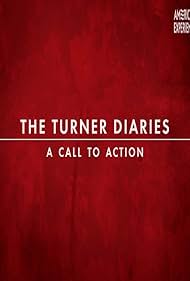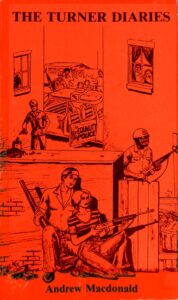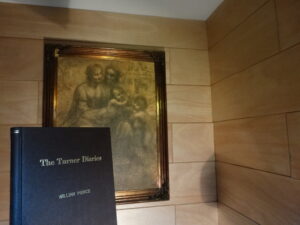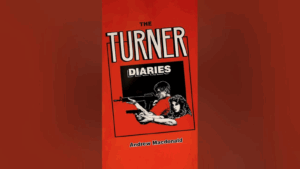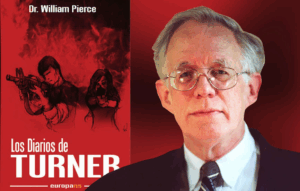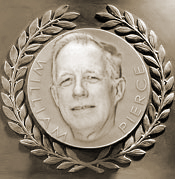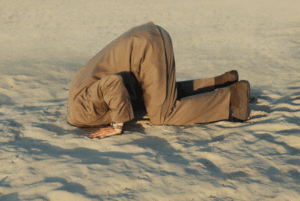of The Turner Diaries, 7
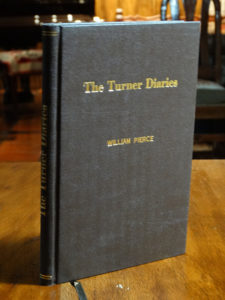 On the other hand, it’ll do these bumpkins around here a lot of good to get a full dose of Big Brother’s loving care. Most of them hardly ever see a Black or a Jew, and they act as if there’s not a war going on. They seem to think that they’re far enough away from the things that are plaguing other parts of the country that they can keep on with their same old routine. They resent any hint that they may have to halt their pursuit of pleasure and affluence long enough to cut a cancer out of America that will surely destroy us all if it’s not eliminated soon. But it’s always been that way with Boobus Americanus. [page 130]
On the other hand, it’ll do these bumpkins around here a lot of good to get a full dose of Big Brother’s loving care. Most of them hardly ever see a Black or a Jew, and they act as if there’s not a war going on. They seem to think that they’re far enough away from the things that are plaguing other parts of the country that they can keep on with their same old routine. They resent any hint that they may have to halt their pursuit of pleasure and affluence long enough to cut a cancer out of America that will surely destroy us all if it’s not eliminated soon. But it’s always been that way with Boobus Americanus. [page 130]
______ 卐 ______
The danger in not constantly escalating the war is that the System will find a new equilibrium, and the public will become accustomed to it. The only way to maintain the present influx of recruits is to keep a substantial portion of the public psychologically off balance—keep them at least half convinced that the System isn’t strong enough and efficient enough to wipe us out, that we are an irresistible force, that sooner or later the war will sweep them, too, up in it.
Otherwise, the worthless bastards will take the easy way out by just sitting back to see what happens. The American people have already proved that they can shamelessly continue their crass pursuit of pleasure under the most provocative conditions imaginable—so long as new provocations are introduced gradually enough for them to become accustomed to them. That’s our greatest danger in not acting. [page 135]
______ 卐 ______
Now, however, we’re the ones with the job of restoring order, and it’s going to be a bitch. The people are absolutely out of their minds with fear and panic. They are behaving in an entirely irrational manner, and a great number of lives are bound to be sacrificed before we get things under control. Partly, I’m afraid, starvation and exhaustion are going to have to do it for us, because our manpower and other material resources are entirely inadequate for the task. […]
On top of all that, we wreaked real havoc on the civilian population. Power plants, communication facilities, dams, key highway interchanges, tank farms, gas pipelines, and everything else that could be blown up or burned down was hit Monday morning in an all-out effort, all across the country, to cause civilian panic and keep the System temporarily occupied with the attendant problems.
I also learned that, along with everything else, the raid on the Evanston Project took place Monday morning. I was immensely pleased to hear that it was a complete success.
So the net result was that, by the time the System had assessed the situation and had regained enough confidence in the loyalty of any of its military units to try to move against us, we had finished mopping up Vandenberg and had issued our ultimatum: any military move against us would result in our launching nuclear missiles targeted on New York City and Tel Aviv. And that’s why things have been so quiet for the last few days!
And now I understand Revolutionary Command’s whole strategy, which had eluded me for so long and caused me so many misgivings. RC realized all along that there was no way, with our present numbers, that we could sustain a military assault against the System on a large enough scale for a long enough time to bring it down. We could have continued our guerrilla campaign of economic sabotage and psychological warfare for quite a while, of course, but time was ultimately on the side of the System. Unless we could make some really dramatic breakthrough which would increase our numbers substantially, the System’s growing police powers would eventually paralyze us.
Well, we’ve made the breakthrough now. And we’ve got the potential, at least, for some very substantial growth; there are some twelve million people under our control in the Los Angeles metropolitan area alone. […] But ideologically they are in poor shape! Some of them are vaguely on our side; others are still chock-full of System brainwashing; and most are somewhere in between. [pages 145-148]
